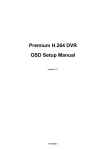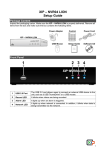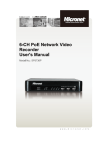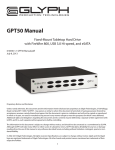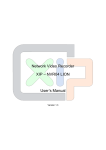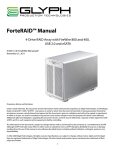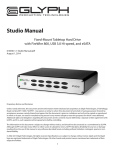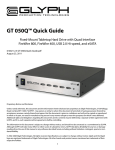Download Network Video Recorder XIP-NVR04 LION OSD Setup
Transcript
Network Video Recorder XIP-NVR04 LION OSD Setup Manual Version 1.1 OSD Setup Manual Table of Contents Menu System Overview ..................................................................................................... 7 < Account and Password > ........................................................................................... 7 < Key Usage of Virtual Keyboard >............................................................................... 8 System Setup ..................................................................................................................... 9 < System/Version Info > ................................................................................................ 9 Model Name ................................................................................................... 9 Video System ................................................................................................. 9 Hardware ........................................................................................................ 9 Software ......................................................................................................... 9 MAC Address 1 .............................................................................................. 9 Software Upgrade......................................................................................... 10 Software Upgrade Via Internet ..................................................................... 10 < Camera Info > .......................................................................................................... 11 < Language > ............................................................................................................. 11 < Date / Time > ........................................................................................................... 11 Date / Time ................................................................................................... 11 Time Zone .................................................................................................... 12 Date / Time Display ...................................................................................... 12 Date Display Mode ....................................................................................... 12 Time Display Mode ....................................................................................... 12 Daylight Saving Time Setup ......................................................................... 13 - Daylight Saving Time ...................................................................... 13 - DST Start / End ............................................................................... 13 - DST Bias ......................................................................................... 13 Network Time Protocol Setup ....................................................................... 13 - NTP Server ..................................................................................... 14 - Automatically Time Sync ................................................................. 14 - Manually Time Sync ........................................................................ 14 < Unit Name > ............................................................................................................ 14 < Show Unit Name >................................................................................................... 14 < User Management > ................................................................................................ 15 Password Protection .................................................................................... 15 Auto Logout .................................................................................................. 15 Account Setup .............................................................................................. 15 Permissions Setup ....................................................................................... 16 Load Default Setting ..................................................................................... 16 < Network Setup > ...................................................................................................... 17 LAN Select ................................................................................................... 17 1 OSD Setup Manual LAN Setup .................................................................................................... 18 - DHCP .............................................................................................. 18 IP .................................................................................................... 18 Netmask .......................................................................................... 19 Gateway .......................................................................................... 19 DNS ................................................................................................ 19 PPPoE Account ............................................................................... 20 PPPoE Password ............................................................................ 20 PPPoE Max Idle .............................................................................. 20 Connect At Booting ......................................................................... 20 - Network Restart .............................................................................. 20 Web Port ...................................................................................................... 20 Email Address .............................................................................................. 21 SMTP Setup ................................................................................................. 21 - Email via SMTP .............................................................................. 21 SMTP Server .................................................................................. 22 SMTP Port ...................................................................................... 22 SMTP Account ................................................................................ 22 SMTP Password ............................................................................. 22 - Use SSL Connection ....................................................................... 23 DDNS Setup ................................................................................................. 23 - Enable DDNS .................................................................................. 23 Service Provider .............................................................................. 23 Host Name ...................................................................................... 24 DDNS Port ...................................................................................... 24 DDNS Account ................................................................................ 24 DDNS Password ............................................................................. 24 Submit / Update .............................................................................. 25 - ezDDNS .......................................................................................... 25 UPnP Setup.................................................................................................. 25 - UPnP............................................................................................... 25 - UPnP NAT Traversal ....................................................................... 26 < Audio Output / Key Beep > ...................................................................................... 26 Audio Output ................................................................................................ 26 Audio Output Gain ........................................................................................ 26 Key Beep ...................................................................................................... 26 Monitor Setup ................................................................................................................... 27 < Show Camera Name > ............................................................................................ 27 < Monitor Brightness >................................................................................................ 27 < Monitor Contrast > ................................................................................................... 27 2 OSD Setup Manual < Monitor Chrominance > ........................................................................................... 27 < OSD Transparency > ............................................................................................... 27 < VGA Resolution > .................................................................................................... 28 < Mouse Sensitivity >.................................................................................................. 28 < Hide Status Bar >..................................................................................................... 28 < Status Bar Size > ..................................................................................................... 28 Camera Setup ................................................................................................................... 29 < IP Camera Select > ................................................................................................. 29 < IP Camera Name > .................................................................................................. 29 < IP Camera Covert > ................................................................................................. 30 < Enable PnP >........................................................................................................... 30 < Device Search > ...................................................................................................... 30 < Hostname / IP > ....................................................................................................... 30 < Model >.................................................................................................................... 30 < Connection Setup > ................................................................................................. 31 Account ........................................................................................................ 31 Password...................................................................................................... 31 Management Port ......................................................................................... 31 Main Stream Setup ....................................................................................... 31 Dual Stream Setup ....................................................................................... 32 IP Dome Protocol ......................................................................................... 32 IP Dome ID ................................................................................................... 32 < Device Setup > ........................................................................................................ 33 Product ID .................................................................................................... 33 Image Resolution ......................................................................................... 33 Enable H264-1 CBR Mode / Enable H264-2 CBR Mode .............................. 34 Sharpness / Brightness / Contrast ................................................................ 34 Apply ............................................................................................................ 34 < Activated > ............................................................................................................... 35 < Status > ................................................................................................................... 35 < Copy Settings > ....................................................................................................... 35 Record Setup ................................................................................................................... 36 < Schedule Setup > .................................................................................................... 36 Day / Night Time Start / End ......................................................................... 36 Weekend Schedule ...................................................................................... 37 Weekend Start / End..................................................................................... 37 < Preset Record Configuration > ................................................................................ 37 < Advance Schedule Setup > ..................................................................................... 37 Schedule Table ............................................................................................. 38 Recording Profile Setup ............................................................................... 39 3 OSD Setup Manual - Camera Select ................................................................................ 39 - Normal PPS .................................................................................... 39 - Normal Qlty ..................................................................................... 39 - Event PPS....................................................................................... 39 - Event Qlty ....................................................................................... 39 - Copy Settings.................................................................................. 40 Holiday Setup ............................................................................................... 40 < Data Lifetime Setup > .............................................................................................. 40 Data Lifetime Mode ...................................................................................... 40 Data Lifetime ................................................................................................ 40 Data Lifetime By Day .................................................................................... 41 Data Lifetime By Channel ............................................................................. 41 < Circular Recording > ................................................................................................ 41 < Audio Recording > ................................................................................................... 42 < Purge Data > ........................................................................................................... 42 Purge All Data .............................................................................................. 42 Purge All Event Data .................................................................................... 42 Purge Event Before ...................................................................................... 42 Start To Purge ............................................................................................... 42 Sequence Setup ............................................................................................................... 43 < Main Monitor Dwell > ............................................................................................... 43 < Main Monitor Schedule > ......................................................................................... 43 Event Setup ...................................................................................................................... 44 < Internal Buzzer > ..................................................................................................... 44 < Event Icon > ............................................................................................................ 44 < Email Notice > ......................................................................................................... 44 < Email Attachment >.................................................................................................. 45 < Alert Notification Setup > ......................................................................................... 45 Alert Configuration Set ................................................................................. 45 Alert Notification ........................................................................................... 45 Alert IP.......................................................................................................... 45 Alert Port ...................................................................................................... 45 Alive Interval ................................................................................................. 46 < Event Full Screen > ................................................................................................. 46 < Event Duration > ...................................................................................................... 46 < Per Channel Config > .............................................................................................. 46 Channel Select ............................................................................................. 46 Video Loss Detect ........................................................................................ 46 Motion Detect ............................................................................................... 47 Detection Config ........................................................................................... 47 4 OSD Setup Manual - Detected Area Setup ....................................................................... 47 - Sensitivity ........................................................................................ 48 - Area Threshold ............................................................................... 48 Alarm In ........................................................................................................ 48 Event Trigger Preset ..................................................................................... 49 Copy Event Settings ..................................................................................... 49 Database Setup ................................................................................................................ 50 < Total / Free Size of HDD > ....................................................................................... 50 < Avail. Rec Time > ..................................................................................................... 50 < Est. Rec Period >..................................................................................................... 50 < Internal / External Disks > ........................................................................................ 51 < Data Protection > ..................................................................................................... 52 < Repair On Power Loss > ......................................................................................... 52 Configuration ................................................................................................................... 53 < Load Factory Default > ............................................................................................ 53 < Import Configuration > ............................................................................................. 53 < Export Configuration > ............................................................................................. 54 Copy Destination .......................................................................................... 54 Configuration Name ..................................................................................... 54 Begin Export ................................................................................................. 54 < System Log >........................................................................................................... 55 < Operation Log > ....................................................................................................... 55 Export ............................................................................................................................... 56 < Select Device >........................................................................................................ 56 < Select Channel > ..................................................................................................... 57 < From / To Time >...................................................................................................... 57 < Select Events >........................................................................................................ 57 < Data Type > ............................................................................................................. 57 < Export Format > ....................................................................................................... 58 < Digital Signature > ................................................................................................... 58 < Begin Export > ......................................................................................................... 58 AUX Setup ........................................................................................................................ 59 < PoE Setup > ............................................................................................................ 59 < PoE Power Limitation > ............................................................................. 59 PoE Port Power ............................................................................................ 59 < PoE Status > ............................................................................................. 60 < UPS Setup > ............................................................................................................ 60 UPS Protocol ................................................................................................ 60 Power Failure Scenario ................................................................................ 60 UPS Shutdown Setting ................................................................................. 61 5 OSD Setup Manual - Min Remaining Battery Level .......................................................... 61 - Min Remaining Run Time ................................................................ 61 - Delay To Activate............................................................................. 61 UPS Info ....................................................................................................... 61 - UPS Model ...................................................................................... 61 UPS Protocol .................................................................................. 62 UPS Status...................................................................................... 62 Remaining Battery Level ................................................................. 62 Remaining Run Time ...................................................................... 62 Query Time ..................................................................................... 62 Shutdown.......................................................................................................................... 63 < Power Off >.............................................................................................................. 63 < Reboot > .................................................................................................................. 63 < Auto Rebooting > ..................................................................................................... 63 < Rebooting Time > .................................................................................................... 63 Appendix A: NVR Player.................................................................................................. 64 Appendix B: HDD COPY TOOL (EXT2IFS) ..................................................................... 69 6 OSD Setup Manual Menu System Overview The detailed functions and settings of the XIP-NVR04 LION can be set through the intuitive Graphical User Interface (GUI) OSD setup menu. Collaborating with a USB mouse, setting up the NVR can be easy as operating a PC. This chapter particularizes the items and options in the OSD setup menu. < Account and Password > Click on the MENU icon in the Live Panel and select an account to login. There are two preset accounts: “admin” and “user”. Next, enter a corresponding password. The preset password for the administrator account “admin” is “1234”, while the preset password for the account “user” is “4321”. NOTE: It is strongly suggested to change the preset password to prevent unauthorized access to the unit. An icon displayed at the status bar will show the authority level of the account. Under logout condition, the icon will be “Guest”. When an account is logged in, its authority level number (1~8) will be shown. Before users logout, other functions can also be accessed without having to login again. There are two ways to logout: manually logout by clicking on the ESC icon in the Live Panel, or auto logout when users are not using the NVR for a preset period of time (default 5 minutes) at Live/ Menu mode. 7 OSD Setup Manual < Key Usage of Virtual Keyboard > A virtual keyboard shows in some setting items, such as camera title, e-mail address, etc. The virtual keyboard displays as below. ! @ # 1 2 3 A B C N O P a b c n o p << * 4 5 D E Q R d e q r >> _ + 6 F S f s = 7 , 8 . 9 G H I J T U V W g h i j t u v w Space Cancel / 0 K X k x ← Del L M Y Z l m y z OK <To input characters> Click on the desired characters to select characters. <To move the cursor in title entry field> Select “<<” / “>>” or just use the USB mouse to move the cursor to left / right in the title entry field. <To delete previous character> Click on <←> to delete characters. <To delete current character> Click on <Del> to delete characters. <To exit the virtual keyboard> Click on <OK> to save the settings and exit. Otherwise, select <Cancel> to exit without saving changes. NOTE: If a USB keyboard is connected and when any key on the keyboard is pressed, the cursor on the virtual keyboard will be automatically moved to <OK>. 8 OSD Setup Manual System Setup Select <System> from Main Menu to enter the System menu. System System/Version Info Camera Info Language Date/Time Unit Name Show Unit Name User Management Network Setup Audio Output/Key Beep English NVR No < System/Version Info > The System/Version Info menu allows users to view system information, such as hardware and software version. From the System menu, select <System/Version Info>, and the following menu is displayed. The first five items are “read-only”, for users’ information only. The items in this menu are described in the following subsections. System/Version Info Model Name Video System Hardware Software MAC Address 1 Software Upgrade Software Upgrade Via Internet **** NTSC ****-****-**** ****-****-****-**** **:**:**:**:**:** Model Name This item shows the model name of the unit. Video System This item shows the current video system of the unit. Hardware The item identifies the hardware version for this unit. Software The item identifies the software version installed on this unit. MAC Address 1 This item identifies the first Media Access Control (MAC) address of the unit. 9 OSD Setup Manual Software Upgrade This item is used for upgrading software of the XIP-NVR04 LION by local device. The menu is displayed as follows. Software Upgrade via Local Device Upgrade Version xxxx-xxxx-xxxx-xxxx Select No Connect a USB drive containing upgrade software to the unit. The available upgrade files will be listed in the menu. To update the system, select a file and select <Yes> to start the upgrade process. The XIP-NVR04 LION loads the software, updates the system files, and reboots automatically. The upgrade process may take several minutes to save the changes in the memory of the system. After the unit is rebooted, please check the software version again. NOTE: No power interruption is allowed during the software update. NOTE: Do not remove the external USB ThumbDrive® before the unit completely shuts down. Removing the external USB ThumbDrive® before shutting down can cause the system to update improperly. Software Upgrade Via Internet This item is used to upgrade the unit’s software via the internet. Select one of the listed software versions and choose <Yes>. The XIP-NVR04 LION downloads the software, updates the system files, and reboots automatically. 10 OSD Setup Manual < Camera Info > Users can find information about main stream and dual stream of the connected IP cameras under this menu. Ch CH01-Main CH02-Main CH03-Main CH04-Main Camera Info Format Resolution PPS Bandwidth H264(MP) 1080P 25.40 2139.59 kbps ------------------------------------- < Language > The Language item allows users to select the language for the OSD setup menu and screen messages. Language selection takes effect immediately when the selection is made. Click the pull-down list next to <Language> to select a preferred language. < Date / Time > Users can set the current date, time and other OSD parameters in this menu. In System menu, select <Date/Time>; the Date/Time menu displays as follows. Date/Time Date Time Time Zone Date/Time Display Date Display Mode Time Display Mode Daylight Saving Time Setup Network Time Protocol Setup 2014/01/21 PM 10:39:26 OFF 1 Row Y/M/D 12 HR NOTE: The reset of Date / Time setting only applies to new videos. The date and time of previously recorded video will not be changed. NOTE: To avoid record database corruption, clearing the database is recommended after changing Date / Time setting. Date / Time Select <Date> or <Time> to adjust the settings. UP / DOWN are used to change the value in the selected field. 11 OSD Setup Manual Time Zone Click the box next to <Time Zone> to select user’s local time zone. Please refer to the following figure or visit wwp.greenwichmeantime.com to find users’ local time zone. NOTE: <Time Zone> must be set to users’ local time zone, or the <Network Time Protocol Setup> will not be accessible. Date / Time Display Users are allowed to set the date / time OSD displays in 1 or 2 rows, or disable (OFF) this item. Choose a preferred format from the pull-down list. Date Display Mode This item allows user to set the OSD display type of the date. Three options are provided: <Y/M/D>, <M/D/Y> or <D/M/Y>. “Y” represents “Year”, “M” represents “Month” and “D” represents “Day”. Choose a preferred type from the pull-down list. Time Display Mode User can set the time format to <12HR> or <24HR>. Choose a desired format from the pull-down list. 12 OSD Setup Manual Daylight Saving Time Setup This function is for people who live in certain regions to observe Daylight Saving Time (DST). The menu displays as follows. Daylight Saving Time Setup Daylight Saving Time Off DST Start Mar Last Sun 01:00 DST End Oct Last Sun 01:00 DST Bias 60 Min - Daylight Saving Time Select <On> to enable, or <Off> to disable the function. If the function is disabled, the DST Start / End time and DST Bias will be grayed out and cannot be accessed. If this function is enabled, the date / time information will be shown on the screen with a DST icon when playing back recorded video or searching video in the event list. “S” indicates summer time and “W” indicates wintertime. - DST Start / End These items are used to set the daylight saving duration. Choose time from the pull-down list and click UP / DOWN buttons to change the settings. - DST Bias This item allows the user to set the amount of time to move forward from the standard time for daylight saving time. Available options are <30>, <60>, <90>, and <120> minutes. Network Time Protocol Setup After time zone is set, the <Network Time Protocol Setup> option will be available. Network Time Protocol Setup NTP Server Automatically Time Sync Manually Time Sync time.nist.gov Off No 13 OSD Setup Manual - NTP Server Enter this item to setup a feasible time server. The default time server is time.nist.gov. Users can change it to any other time server if desired. IP addresses of other time servers are listed below for reference. 129.6.15.28 132.163.4.102 192.43.244.18 206.246.118.250 207.200.81.113 129.6.15.29 132.163.4.103 131.107.1.10 208.184.49.9 64.236.96.53 132.163.4.101 128.138.140.44 69.25.96.13 64.125.78.85 68.216.79.113 - Automatically Time Sync Select <ON> and the time will be synced once an hour. - Manually Time Sync Select <Yes> to sync the time immediately. < Unit Name > Users are allowed to assign a name, up to 11 characters, to the XIP-NVR04 LION. Follow the steps to edit the unit name. Click <Unit Name> or the box next to <Unit Name>. A virtual keyboard displays as below. ! @ # 1 2 3 A B C N O P a b c n o p << * 4 5 D E Q R d e q r >> _ + 6 F S f s = 7 , 8 . 9 G H I J T U V W g h i j t u v w Space Cancel / 0 K X k x ← Del L M Y Z l M y Z OK Click to add the wanted character to the entry field (up to 11 characters). When the unit name is entered, click <OK> to save the settings and exit. < Show Unit Name > This item enables the unit name of the XIP-NVR04 LION to be shown on the monitor. Select <Yes> to show or select <No> to hide. 14 OSD Setup Manual < User Management > The NVR provides the option to create up to seven sets of usernames and passwords with customized authority, excluding the preset “admin” account. The menu is as the following. User Management Password Protection Auto Logout Account Setup Permission Setup Load Default Setting On 300 Sec No Password Protection Select <On> to request for username and password for accessing functions listed in Permissions Setup menu, or select <Off> to allow free access. Auto Logout Users can setup time for automatic logout of system when no operation is performed. Select from <60 Sec>, <120 Sec>, <300 Sec> and <600 Sec>. Alternatively, select <Disable>, and the system will not automatically logout. Account Setup Setup customized account, password, and privilege level in this menu. Click the box next <Account> to select items. The account is case sensitive. The privilege level ranks from level 1~8, and level 8 is the highest authority level. Alternatively, select <Disable> to stop using the account. A second password can also be specified, if required. Account Setup Account: Password: Privilege: 2nd PW… 2nd PWD: admin **** Level 8 Off Mod Mod Mod . Confirm Cancel NOTE: The account and privilege level of the preset administrator account “admin” cannot be changed. 15 OSD Setup Manual Permissions Setup Users can setup the authority level to access the functions in this setting. The functions include: Playback/Search, Covert Camera, Dome Control, Live Operation, Export Data, Menu Access, System Setup, Monitor Setup, Camera Setup, Record Setup, Sequence Setup, Event Setup, Database Setup, Configuration, AUX Setup, and Shutdown. Scroll to view these items. In accordance with users’ privilege level defined in <Account Setup>, the authority level here also ranks from levels 1~8. Level 8 is the highest authority level. Users can access any function that is equivalent to or lower than their privilege level. Alternatively, select <Disable> to allow free access. Permission Setup Item Playback/Search Covert Camera Dome Control Live Operation Export Data Menu Access Authority Disable Level 8 Disable Disable Disable Level 4 NOTE: The “Menu Access” cannot be set to <Disable>. When the account does not have authority to access certain functions, an error message will be displayed on the screen. Load Default Setting This item is to restore the default settings. Select <Yes> to load default setting or select <No> to exit. 16 OSD Setup Manual < Network Setup > The Network Setup menu allows users with proper privilege to configure the network by specifying the network related settings, such as IP address, Netmask, etc. Check with the network administrator and/or network service provider for specific information. The menu is as the following. Items in this menu are described in the following sections. Network Setup LAN Select LAN Setup Web Port Email Address SMTP Setup DDNS Setup UPnP Setup LAN 80 LAN Select This item allows users to select the service type among <LAN>, <PPPoE>, and <None>. If the internet connection is a local area network communication, please select <LAN>. If users are using a broadband communication medium, such as DSL Line or cable modem, please select <PPPoE>. PPPoE stands for Point-to-Point Protocol over Ethernet. It is a specification for connecting the users on an Ethernet to the Internet through a common broadband medium. If <None> is selected, then there is no need to set further LAN / PPPoE settings. Therefore, the second item <LAN Setup> will be inaccessible. 17 OSD Setup Manual LAN Setup The network related settings in the LAN Setup menu should be associated with the network service type. If users select <LAN> for <LAN Select>, then the PPPoE related menu items will not be displayed. Select <LAN Setup> in Network Setup menu and use the virtual keyboard to set parameters. The menu displays as follows. LAN Setup DHCP IP Netmask Gateway DNS PPPoE Account PPPoE Password PPPoE Max Idle Connect At Booting Network Restart On 192.168.1.150 255.255.255.0 192.168.1.1 192.168.10.1 0 Min Yes No - DHCP This item allows user to obtain a dynamic IP address from DHCP (Dynamic Host Configuration Protocol) server when the NVR boots up. When using DHCP, the settings are dynamic and will be changed every time the NVR powers up or off. If DHCP is enabled (On), a dynamic IP will be assigned to the XIP-NVR04 LION. In this case, users do not need to configure the Ethernet settings, including IP address, Netmask, Gateway and DNS settings. These settings will be “read-only”. If users wish to use a permanent address, set DHCP to <Off> to manually set IP Address, Netmask, Gateway, and DNS. Check with the network system administrators or IT personnel for appropriate values for these settings. - IP The item is used to configure the IP (Internet Protocol) address of the NVR. The IP address is the identifier for the NVR on a TCP/IP LAN or WAN. Note that to set a static IP address, DHCP must be set to <Off>. NOTE: The IP address cannot be set to “192.168.50.*” due to the specific IP is reserved for NAS devices. 18 OSD Setup Manual - Netmask Netmask is a 32-bit mask used to divide an IP address into subnets and specify the networks available hosts. Its value is defined by the network administrator. It takes the form as ***.***.***.***, for example, 255.255.255.255. This item allows users to enter the value of the Netmask for the unit. Please note that to configure the item, DHCP must be set to <Off>. - Gateway Gateway is a node on a network that serves as an entrance to another network. Users are allowed to specify the IP address of the gateway or router associated with this unit. To configure this item, DHCP must be set to <Off>. - DNS DNS is the abbreviation for “Domain Name System”, which is an Internet service that translates domain names (eg: www.DNS.com) into IP addresses. It helps to make our life easier because we do not have to memorize IP address but just the domain names, which are easier to be memorized. The item allows users to specify the IP address of the Domain Name System associated with the unit. To configure this item, DHCP must be set to <OFF>. If the network server is unavailable when using DHCP, the unit searches for the network server and boots up slower than usual. The network searching continues until it times out. 19 OSD Setup Manual - PPPoE Account The item allows users to setup the PPPoE login username. NOTE: For accessing the PPPoE settings, select <PPPoE> as the Network Type under LAN Select menu. To setup the login username, follow the steps below: Select <PPPoE Account> from LAN Setup menu. A virtual keyboard displays. Click to add characters to the entry field. When it is done, click <OK> to save the setting and exit. - PPPoE Password The item allows users to setup the PPPoE password. Follow the steps to setup the login password. Select <PPPoE Password> from LAN Setup menu and a virtual keyboard displays. Click to add characters to the entry field. When it is done, click <OK> to save the setting and exit. - PPPoE Max Idle The item indicates the duration that the modem connection remains active if there is no acknowledgement from the remote PC. Users can select the idle time from 0 to 600 minutes. - Connect At Booting The unit is allowed to automatically connect to the internet when it is powered up. Select <Yes> to connect at booting; otherwise, select <No>. - Network Restart Network restart is required after network settings are changed. Select <Yes> to restart the network connection. Web Port To avoid the default service port (port 80) being jammed, this item enables users to change port 80 to another port. To change the web port, users can click on UP / DOWN buttons to adjust the setting. 20 OSD Setup Manual Email Address This item is used to edit the e-mail address where event / alarm notification will be sent. Follow these steps to setup the e-mail address. Click on the box or the keyboard icon next to <Email Address>. A virtual keyboard displays. Click to add the e-mail address to the entry field. When it is done, click <OK> to save the settings and exit. NOTE: For more details of event / alarm notification, please refer to section Email Notice. SMTP Setup Simple Mail Transfer Protocol (SMTP) is a protocol for sending e-mail messages between servers. SMTP is a relatively simple, text-based protocol that one or more recipients of a message are specified and the message text is transferred. Select <SMTP Setup> from Network Setup menu; the menu displays as follows. SMTP Setup Email Via SMTP SMTP Server SMTP Port SMTP Account SMTP Password Use SSL Connection Off 25 Off - Email via SMTP The item enables users to determine if the unit sends e-mail via SMTP. Select <On> to send e-mail via SMTP; if not, select <Off>. 21 OSD Setup Manual - SMTP Server This item enables users to set the SMTP server. Contact the network service provider for more specific information. Follow the steps to setup the SMTP Server. Select <SMTP Server> from SMTP Setup menu. A virtual keyboard displays. ! @ # 1 2 3 A B C N O P a b c n o p << * 4 5 D E Q R d e q r >> _ + 6 F S f s = , . / 7 8 9 0 G H I J K T U V W X g h i j k t u v w x Space Cancel ← Del L M Y Z l m y z OK Click to add character to the entry field. When it is done, click <OK> to save the settings and exit. - SMTP Port The item is used to change SMTP port to another port, if necessary. SMTP usually is implemented to operate over Internet port 25. To change the SMTP port, click on UP / DOWN buttons to change the values in the selected field. - SMTP Account The item allows users to setup the SMTP username. Refer to the following steps to setup the login username. Click <SMTP Account> from SMTP Setup menu. A virtual keyboard displays. Click to add the desired character to the entry field. When it is done, click <OK> to save the settings and exit. - SMTP Password The item is for users to setup the SMTP password. Follow the steps below to set the password. Select <SMTP password> from SMTP Setup menu. A virtual keyboard displays. 22 OSD Setup Manual Click to add the desired characters to the entry field. When it is complete, click <OK> to save the settings and exit. - Use SSL Connection SSL stands for Secure Sockets Layer, which provides communications security over the Internet. Select <On> for this item to enable SSL connection. Otherwise, select <Off> to disable SSL connection. DDNS Setup Dynamic Domain Name System (DDNS) allows a DNS name to be constantly synchronized with a dynamic IP address. In other words, it allows a dynamic IP address to be associated to a static domain name, so users can connect to it by the domain name. Select <DDNS Setup> from Network Setup. The menu displays as below. DDNS Setup Enable DDNS Service Provider Host Name DDNS Port DDNS Account DDNS Password Submit/Update ezDDNS Off Iview-ddns XXXXXX 80 No No - Enable DDNS The item is used to enable or disable the Dynamic Domain Name Service. Select <On> to enable the service, or <Off> to disable. - Service Provider There are three different service providers: <iview-ddns>, <dyndns> and <ChangeIP>. When <iview-ddns> is selected, users can setup preferred <Host Name> and <DDNS Port>. The DDNS address will be as http://hostname.ddns.iview-ddns.com after users submit the setting. For example, if the chosen host name is “H264NVR”, then the address will be: http://H264NVR.ddns.iview-ddns.com. Alternatively, when <dyndns> is selected, users need to first obtain accounts from the website http://dyn.com/dns/. The further required items are <Host Name>, <DDNS Account>, and <DDNS Password>. 23 OSD Setup Manual NOTE: If <dyndns> or <ChangeIP> is selected, <DDNS Port> and <ezDDNS> will be grayed out. The ezDDNS function is only available for the iview-ddns provider. - Host Name The item allows users to setup a domain name, which is used for accessing the XIP-NVR04 LION through the internet on the remote PC. To setup the Host Name of the unit, follow the steps below. Select <Host Name> from DDNS Setup menu. A virtual keyboard displays as below. ! @ # 1 2 3 A B C N O P a b c n o p << * 4 5 D E Q R d e q r >> _ + 6 F S f s = , . / 7 8 9 0 G H I J K T U V W X g h i j k t u v w x Space Cancel ← Del L M Y Z l m y z OK Click to add the preferred characters to the entry field. When it is finished, click <OK> to save the settings and exit. NOTE: Each XIP-NVR04 LION should have its unique host name. - DDNS Port Users can setup the port for DDNS. Click UP / DOWN to change the port. - DDNS Account Users who use DynDNS or ChangeIP as the service provider have to input a DDNS account name. Follow the same step as described in <Host Name> setup to input a valid account name. - DDNS Password Users who use DynDNS or ChangeIP as the service provider have to input a DDNS password. Follow the same step as described in <Host Name> setup to input the password goes with the valid user name. 24 OSD Setup Manual - Submit / Update After the setting is completed, select <Yes> to submit the settings. NOTE: If more than one XIP-NVR04 LION has the same domain name, only the first one will be submitted successfully. - ezDDNS ezDDNS enables users to register for the host name automatically. Select <Yes>, and the following will be displayed. ezDDNS Submit/update ok! Host name is XXXXXX.ddns.iview-ddns.com Press any key to return NOTE: The NVR must be connected to the *Real IP address, or be assigned a specific port using **Port Forwarding technique. *A “Real IP” is the IP address that is assigned to users by the ISP. **A “Virtual IP” is the IP address assigned either manually or through DHCP. When the user is assigned a Virtual IP, the user must use Port Forwarding technique to assign a specific port to the NVR. UPnP Setup UPnP is the abbreviation for Universal Plug and Play, which is a technology that integrates a universal protocol for widespread plug-and-play devices to ease the network implementation. When a PC and an NVR are both installed the UPnP function, the PC can automatically recognize the NVR in the same local area network. The advantage of this function is that PCs can connect to the NVR via the remote control software by directly clicking on the icon representing the NVR in <My Network Places> folder. The menu will be as the following. UPnP Setup UPnP UPnP NAT Traversal Off No - UPnP Set the first item UPnP to <ON> and the NVR is now with UPnP function. 25 OSD Setup Manual - UPnP NAT Traversal The UPnP NAT traversal function will help to automatically setup a router if the NVR connects to the internet via a router. Select <Yes> and the settings of router will be taken care by the NVR itself. < Audio Output / Key Beep > Enter this item to setup the audio output or key beep. Audio Output/Key Beep Audio Output Audio Output Gain Key Beep Live/PB 0 On Audio Output The item is used to set the audio output mode. The available options are as follows. Live/PB: Select the item to play the recording sounds of live image in live mode, and sounds of recorded video in playback mode respectively. OFF: Select the item to disable the audio output function. Audio Output Gain The item is used to adjust volume of the audio. The greater the value is, the louder the sound. The value ranges from -3 to 3. 3 is the maximum volume, 0 indicates the volume has not been altered, and -3 is the minimum volume. Key Beep The item is used to enable or disable the key tone. Select <On> to enable the key tone, or <Off> to disable. 26 OSD Setup Manual Monitor Setup The Monitor Setup menu allows users to adjust the quality of the displayed image. To configure the monitor settings, select <Monitor> from the Main Menu. Monitor Show Camera Name Monitor Brightness Monitor Contrast Monitor Chrominance OSD Transparency VGA Resolution Mouse Sensitivity Hide Status Bar Status Bar Size Yes 0 0 0 0% 720P 90% No Medium < Show Camera Name > This item allows users to choose whether to display the camera name on the screen. The default is <Yes>, which displays the camera names with the video. < Monitor Brightness > This item is for users to adjust the brightness of the monitor. Click on Up / DOWN buttons to adjust the value. Users can also click on the <Num> icon next to <Monitor Brightness> to directly select the value from the numeral keyboard. The value ranges from <-32> to <31>. < Monitor Contrast > This item is used to adjust the color contrast of the monitor. Click on Up / DOWN buttons to adjust the value. The range of the contrast value is <-32> to <31>. < Monitor Chrominance > This item can be used to adjust the chrominance of the monitor. Users can adjust the value by clicking on Up / DOWN buttons. The value of the monitor chrominance ranges from <-32> to <31>. < OSD Transparency > This item allows users to set the OSD menu transparent in a certain degree, so that users can see the live images while configuring the OSD settings. The options are <0%>, <15%>, <30%>, <45%>, <60%>, <75%>, and <90%>. 27 OSD Setup Manual < VGA Resolution > This item allows users to select appropriate VGA resolution for the monitor. The options of VGA resolution are: <1024×768>, <1280×1024>, <720P>, and <1080P>. The preset is <720P>. NOTE: If the selected VGA resolution is too high for the monitor, an error message will be shown on the screen. < Mouse Sensitivity > This item allows users to set the sensitivity of the connected mouse. Starting from <10%>, with 10% increment, the maximum value is <100%>. < Hide Status Bar > Users can choose whether to hide the status bar. The default setting is <No>. If users decide to hide the status bar, set this item to <Yes>. < Status Bar Size > This item allows users to select the displaying size of the status bar. The default setting is <Medium>. The other available displaying sizes are <Small> and <Large>. 28 OSD Setup Manual Camera Setup IP cameras can be connected via the PoE ports for PoE supported models, or by the internet via <Camera> setup menu. When IP cameras are connected via the PoE ports, settings of the IP cameras will be automatically retrieved when the PnP function is enabled. IP Camera IP Camera Select IP Camera Name IP Camera Covert Enable PnP Device Search Hostname/IP Model Connection Setup Device Setup Activated Status Copy Settings CH01 Ch01 Off On X.X.X.X NX Series Yes NOTE: If the IP camera is already activated, items <Device Search>, <Hostname/IP>, <Model>, <Connection Setup>, and <Copy Settings> will be grayed out and cannot be accessed. < IP Camera Select > Select an IP camera channel to edit its setting. < IP Camera Name > This item allows users to modify the name of each IP camera connected to the NVR. By default, the titles of IP cameras are numbered from 1 to 8 for 8CH models (4CH models are from 1 to 4). The new name will be displayed on the screen after it is set. Follow the steps below to enter a new name for an IP camera. Click <IP Camera Name> and a virtual keyboard with alphanumeric characters is displayed. ! @ # 1 2 3 A B C N O P a b c n o p * - _ 4 D Q d q 5 E R e r F S f s + 6 = 7 G T g t , 8 H U h u . / 9 0 I J K V W X i j k v w x ← Del L M Y Z l m y z 29 OSD Setup Manual << >> Space Cancel OK Click to add the desired characters to the entry field. Each title can contain up to 11 characters. After name entry is finished, click <OK> to save the setting. Otherwise, either right click the mouse or click <Cancel> to abort. < IP Camera Covert > If users want to hide the display of image from the IP camera, select <On>. Note that the display in the remote monitoring software will also be hidden. Otherwise, select <Off> and the live image will be shown on the monitor. < Enable PnP > For PoE supported models, settings of the IP camera will be automatically retrieved if an IP camera is connected to the PoE port and the plug and play (PnP) function is enabled. Select <On> to enable the PnP function. Alternatively, select <Off> and users can manually configure setting of the IP camera. < Device Search > Click <Device Search> to automatically search for IP cameras installed in the same LAN to the NVR. If the IP cameras are ONVIF devices, “Brand Name/Onvif” will be shown under the “Brand” column. < Hostname / IP > If the IP camera is not UPnP compatible, manually enter the hostname or IP address of the IP camera (e.g. 192.168.1.123). < Model > Select the corresponding protocol of the connected IP camera. 30 OSD Setup Manual < Connection Setup > This item is used to setup the connection of the IP camera. Click this item to enter the following menu. Connection Setup Account Password Management Port Main Stream Setup Dual Stream Setup IP Dome Protocol IP Dome ID **** **** 80 None 0 Account To be entered with the account name of the IP camera. Password To be entered with the password of the IP Camera. Management Port The management port is the default port of the IP camera. Different IP cameras may have different management ports. Main Stream Setup Under this menu, users can setup configuration for the main stream. Main Stream Setup Advance Streaming Options Streaming Index Streaming Port Streaming Protocol Off Stream1 554 RTP+RTSP If users will manually setup streaming index, port, and protocol, set <Advance Streaming Options> to <On>, and select preferred values from the corresponding menu items. Otherwise, keep <Advance Streaming Options> <Off> and the NVR will complete the setting. 31 OSD Setup Manual Dual Stream Setup Under this menu, users can setup configuration for the dual stream. Dual Stream Setup Dual Streaming Support Dual Streaming Recording Adv. Dual Streaming Options Dual Streaming Index Dual Streaming Port Dual Streaming Protocol No Yes Off Stream2 554 RTP+RTSP First, set <Dual Streaming Support> to <Yes> and continue to the rest of the setting. If users wish to record the dual stream, select <Yes> next to <Dual Streaming Recording>. The remaining items are the same as in <Main Stream Setup>. If users will setup streaming index, port, and protocol manually, set <Adv. Dual Streaming Options> to <On> and select preferred values from the corresponding menu items. Otherwise, keep <Adv. Dual Streaming Options> <Off> and the NVR will complete the setting. IP Dome Protocol If the connected device is an IP Dome Camera, select an appropriate IP Dome Protocol from the provided options. IP Dome ID If the connected device is an IP Dome Camera, then select an appropriate IP Dome ID from the provided options. 32 OSD Setup Manual < Device Setup > Enter this item to set the basic settings of the IP camera. Upon entering this item, the following message will be displayed. Collecting data Please wait! If the connection cannot be detected, the following message will be displayed. Please check the <Hostname/IP>, and <Connection Setup> again to make sure the settings are correct. Cannot get config from the IP device When the connection is detected, the following menu will be displayed. NOTE: The <Device Setup> menu may vary from different camera models. Device Setup Product ID Image Resolution Enable H264-1 CBR Mode Enable H264-2 CBR Mode Sharpness Brightness Contrast Apply **** H264(1080P)+H264(VGA) Off Off 4 148 64 No Product ID This item will display the product name of the IP camera. Image Resolution Users can view the Image Resolution of the IP camera. This item is “read-only”. 33 OSD Setup Manual Enable H264-1 CBR Mode / Enable H264-2 CBR Mode These items allow users to select the type of recording bit rate, either CBR (Constant Bit Rate) or VBR (Variable Bit Rate). Under CBR mode, the bit rate will be kept fixed. With the fixed bit rate, the video quality will be maintained consistent. On the other hand, the bit rate changes under VBR mode according to image variation. VBR is useful when the bandwidth is limited. The default of CBR Mode is <Off>, which indicates that VBR mode is <On>. According to different applications, users can decide to use which bit rate mode. If users’ recording top priority is to let the NVR run as stably as possible, setting CBR mode to <Off> (enable VBR mode) is highly recommended. Sharpness / Brightness / Contrast Scroll the mouse wheel to adjust the Sharpness / Brightness / Contrast of the IP camera. Alternatively, click on UP / DOWN buttons to alter the value. Apply Select <Yes> to apply the above settings, and the following message will be displayed. Re-collecting data Please wait! When the settings cannot be applied, the following message will be displayed. Users may need to reduce the resolution, or FPS of the IP camera. Cannot set the IP device Otherwise, the <Device Setup> setting is completed. NOTE: After changing any item under <Device Setup> menu, users MUST select <Apply> to apply the changes, or the settings will remain unchanged. 34 OSD Setup Manual < Activated > Select <Yes> to activate the IP camera, or <No> to deactivate it. NOTE: Once the connection to the IP camera is activated, menu items <Device Search>, <Hostname/IP>,<Model>, <Connection Setup>, and <Copy Settings> will be grayed out and cannot be accessed. < Status > After activating the IP camera, the <Status> item will be shown. Enter this item to see the current status of the IP camera. Status Model Streaming Format Resolution PPS Bandwidth Pkg. lost rate H264(MP) 1080P 15.00 101.05 kbps 0.00% Nx Series H264(MP) 640×480 30.00 34.31 kbps 0.00% Under the <Status> menu, the user will be able to see the model, streaming format, resolution, PPS, bandwidth, and package lost rate of the IP camera. The information is “read-only”. NOTE: The streaming format will show “MP” (main profile), “BL” (base line), or “HP” (high profile), according to the compression of the IP camera. The main profile has higher compression technology. < Copy Settings > This item allows users to copy the settings of the currently-selected IP camera to any other connected IP cameras. Enter this menu and select one or more target IP cameras. Then select <Confirm> to apply the settings. Copy Settings Copy To: 01 02 Select All 03 04 Deselect All 05 06 Confirm 07 08 Cancel 35 OSD Setup Manual Record Setup The following factors will influence the total record time of the XIP-NVR04 LION: HDD capacity Image quality settings The greater the recording rate and the higher the quality setting are, the shorter the recording time. Most of the related factors can be set here in this submenu. The Record menu allows user to set recording quality, recording schedules, and other recording parameters. Click <Record> in the Main Menu, and the following menu will be displayed. Record Schedule Setup Preset Config Advance Schedule Setup Data Lifetime Setup Circular Recording Audio Recording Purge Data Best Quality On On < Schedule Setup > This submenu is used to set the day and night time, or weekend recording schedule. The Night and Day schedules are used to define daytime and night time; the Weekend schedule is tailored for weekends and holidays. Click <Schedule Setup> from the Record menu; the following menu is displayed. Schedule Setup Day Time Start Day Time End Night Time Start Night Time End Weekend Schedule Weekend Start Weekend End AM PM PM AM 06:00 06:00 06:00 06:00 On Fri PM 06:00 Mon AM 06:00 Day / Night Time Start / End The Day / Night Start Time and End Time determines the duration of day / night recording time. Time is indicated in 1-minute increments. The time display format in this menu is based on the setting of <Time Display Mode> in <System>. 36 OSD Setup Manual Weekend Schedule The Weekend Schedule determines whether a weekend schedule is in effect. Choose <On> to enable the related weekend settings. Weekend Start / End The Weekend Start Time indicates the specific day and time that a weekend begins, for example, Fri 18:00. The Weekend End Time indicates the specific time and day that a weekend ends, for example, Mon 06:00. Time is indicated in 1-minute increments. Note that the value users have set indicates when the regular Day and Night scheduling ends, and Weekend recording begins. < Preset Record Configuration > <Preset Config> is used to select the preset recording quality and frame rate. Different preset recording quality levels are offered for users to choose: <Best Quality>, <Standard>, <Extended Record>, and <Event Only>.The default setting is <Best Quality>. NOTE: If <Adv. Schedule> is selected, users need to further setup the configuration in <Advance Schedule Setup> menu. < Advance Schedule Setup > Under <Advance Schedule Setup>, users can setup self-defined recording preset for the preset configuration, <Adv. Schedule>. Click <Advance Schedule Setup>, and the following menu will be displayed. Advance Schedule Setup Schedule Table Recording Profile Setup Holiday Setup NOTE: The <Advance Schedule Setup> menu is only accessible when <Preset Config> is set to <Adv. Schedule>. 37 OSD Setup Manual Schedule Table This menu allows users to assign recording type for days in a week by hour. Moreover, the recording type for pre-defined holidays can also be specified here. Refer to the following steps to setup the schedule table. Click on a preferred recording type at the bottom. Click on any grid of time to assign the selected recording type. Click on any hour on the top to fill up the column. Click on any day on the left to fill up the roll. Define date of the holiday before assigning the recording type. Click on the top left grid to always record with the selected recording type. Click on the <Confirm> button to save the setting. 38 OSD Setup Manual Recording Profile Setup This setup menu is for users to configure the recording details of Profile 1 / 2 / 3 for each channel. The Recording Profile Setup menu is displayed as below. Recording Profile Setup Camera Select Normal PPS Normal Qlty Event PPS Event Qlty Copy Settings Profile 1 30 2560 kbps 30 4096 kbps Profile 2 30 2560 kbps 30 4096 kbps CH01 Profile 3 30 2560 kbps 30 4096 kbps - Camera Select The item is used to select a desired channel for setting the parameters. Click the box next to <Camera Select> to select a channel from the pull-down list. - Normal PPS Normal PPS (Picture per Second) is used to set the recording rate for normal videos. Users can setup different PPS for each channel and profile according to the application. - Normal Qlty The item is used to set the picture size for normal video recording. The available options are listed as follow: <1020 kbps>, <1792 kbps>, <2560 kbps>, <3328 kbps>, and <4096 kbps >. - Event PPS Event PPS is used to set the event recording rate for Event videos. Normally, the Event PPS is set to equal or greater than Normal PPS; the setting depends on the application. If the Event PPS is set to <0>, the XIP-NVR04 LION stops recording event video during alarms. - Event Qlty The item is used to set the picture size for event video recording. The available options are: <1020kbps>, <1792 kbps>, <2560 kbps>, <3328 kbps>, and <4096 kbps>. 39 OSD Setup Manual - Copy Settings This function is for users to copy the settings of the currently-selected IP camera to any other connected IP cameras. Click <Copy Settings> and select one or more target IP cameras. After the selection, click <Confirm> to apply the settings. Holiday Setup Enter this menu to setup the holiday list. Select a date for <Add Holiday> and the date will be added to the holiday list. Select <Holiday List> to see all added holidays. Holiday Setup Holiday List Add Holiday 01/01 < Data Lifetime Setup > Data Lifetime indicates the duration that a video is saved and recallable in the HDD. Only those video recorded within Data Lifetime can be displayed on the screen and played back. The video beyond Data Lifetime will be hidden and cannot be retrieved for playback. Data Lifetime Setup Data Lifetime Mode Data Lifetime Data Lifetime By Day Data Lifetime By Channel General 0 Days NOTE: If users want to playback a video which is beyond the data lifetime, please extend the duration till the recording data / time of the video is included. Data Lifetime Mode This item allows the user to choose preferred data lifetime mode. There are three types of data lifetime mode: General, By Day, and By Channel. When a specific mode is selected, the other two will be grayed out and cannot be accessed. Data Lifetime When data lifetime mode is set as <General>, this item will be accessible. Select this item and click on UP / DOWN buttons to set the data lifetime. The value ranges from <1> to <365> days. Alternatively, select <0> to disable this function. 40 OSD Setup Manual Data Lifetime By Day When data lifetime mode is set as <By Day>, this item can be accessed. Enter this menu and users can setup data lifetime of each weekday separately. The value ranges from <1> to <365> days. Alternatively, select <0> to disable this function. Data Lifetime By Channel When data lifetime mode is set as <By Channel>, this item will be accessible. Enter this menu and users can setup data lifetime of each channel separately. The value ranges from <1> to <365> days. Alternatively, select <0> to disable this function. < Circular Recording > Users can choose to record video in circular mode or in linear mode. If circular mode is selected (set to <On>), the NVR will store new video into the HDD spaces and overwrite the oldest recorded video. Alternatively, if linear mode is selected (set to <Off>), the NVR will stop recording when the HDD is full. When linear mode is selected, the percentage of HDD usage will be displayed as an icon in the status bar. In addition, an alert icon will show in the status bar when HDD usage reaches to 98%. Meanwhile, the internal buzzer will start beeping. 41 OSD Setup Manual < Audio Recording > This item allows users to enable / disable Audio recording function of the NVR. When it is set to <On>, audio input is recorded and saved with the video. When it is set to <Off>, audio is ignored. < Purge Data > This item is used to delete the Normal or Event recording video. In Record menu, select <Purge Data>, and the Purge Data menu is displayed as follows. Purge Data Purge All Data Purge All Event Data Purge Event Before Start To Purge No No 2014/01/01 No Purge All Data The item is used to delete all recorded video from database(s). Set this item to <Yes>, and select <Yes> next to <Start To Purge> to start to delete all data. Purge All Event Data The item is used to delete all event video from database(s). Select <Yes> and start the deletion by setting <Start to Purge> to <Yes>. Purge Event Before The item is used to delete event video before a specific date. Click on the DOWN button to select a preferred time to delete the event data. Start To Purge After selecting the video data users want to delete or setting the date for deletion, set this item to <Yes> to start deleting, or select <No> to cancel. 42 OSD Setup Manual Sequence Setup The Sequence menu allows users to set the camera sequence schedule and dwell time for main monitor. Select <Sequence> in Main Menu; the menu displays as follows. Items in the Sequence menu are described in the subsections. Sequence Main Monitor Dwell Main Monitor Schedule 5 Sec < Main Monitor Dwell > This item is used to set the dwell time, which is the duration of time elapsed before switching to the next channel, of the main monitor. The dwell time is in the range of 1 to 120 seconds. < Main Monitor Schedule > These items are used to set sequence schedules of the main monitor. Click <Main Monitor Schedule>, and the following menu is displayed. Main Monitor Schedule CH1 CH5 ► CH2 ► CH6 Confirm ► ► CH3 CH7 ► CH4 ► CH8 Cancel ► ► Follow these steps to set a sequence: Assign a channel to the order of the sequence. Continue the step until the sequence is completed. To setup a sequence with less than 8 entries, select <None> to end the sequence. A sequence can include up to 8 entries for 8CH models, and up to 4 entries for 4CH models. A camera or multiple cameras can be contained in the sequence multiple times. 43 OSD Setup Manual Event Setup This menu allows users to determine behaviors of the XIP-NVR04 LION in response to alarm events. In the Main Menu, select <Event>, and the following menu is displayed. Items in the Event menu are described in the following subsections. Event Internal Buzzer Event Icon Email Notice Email Attachment Alert Notification Setup Event Full Screen Event Duration Per Channel Config On On Off Off None 20 Sec < Internal Buzzer > This item allows users to enable / disable internal buzzer of the XIP-NVR04 LION. Set to <On>, the buzzer is activated in response to an alarm. Set to <Off>, the buzzer is not activated. < Event Icon > The item enables (On) / disables (Off) the display of Event Icon on the main monitor when an alarm event occurs. The event types are represented by a letter respectively; the descriptions are as the table below. Event Type Description A Alarm In event M Motion detection event L Video loss event < Email Notice > This item enables (On) / disables (Off) the e-mail notification of events / alarms. When an event / alarm is triggered and <Email Notice> is enabled, an e-mail will be sent to the pre-defined e-mail address. Please refer to section Email Address for setting the e-mail address. 44 OSD Setup Manual < Email Attachment > This function is for users to attach the event / alarm video to the notification e-mail. Select <On> to enable this function. Otherwise, select <Off> to send the notification e-mail without attaching the event / alarm video. < Alert Notification Setup > This function allows users to send alert notifications to the CMS program which is installed to the computer. For detailed setup instruction, please refer to the CMS user’s manual. Alert Notification Setup Alert Configuration Set Alert Notification Alert IP Alert Port Alive Interval 1 OFF 0.0.0.0 9999 120 Sec Alert Configuration Set <Alert Configuration Set> provides 3 sets of Alert Notification, IP, and Port. Alert Notification Four options are included in this item, <OFF>, <Event>, <Alive>, and <Both>. <OFF>: The Alert Notification is turned off. <Event>: When the alarm is triggered, the NVR will send an alert message to the CMS. <Alive>: The NVR will send an alive message to the CMS every N second just to show users that the connection between the NVR and CMS is in effect. The time interval N can be adjusted in <Alive Interval>. <Both>: This enables the NVR to send both Event and Alive alert messages to the CMS. Alert IP The Alert IP must match the IP address of the computer. Alert Port The ports for NVR and the CMS Alert MUST be the same. 45 OSD Setup Manual Alive Interval Users can define the time interval (1 to 255 seconds) between each alive message. This item will not be accessible if the alert notification menu is set to <OFF> or <Event>. < Event Full Screen > This function allows the NVR to display the alarm channel in full screen size when an alarm is triggered. Select <Main> to display the alarm channel in full screen when an alarm is triggered. Alternatively, select <None> to disable this function. < Event Duration > This item determines the duration of the buzzer and Alarm Out relay function once an alarm is triggered. The available event duration ranges from 5 seconds to 999 seconds. < Per Channel Config > This menu is used to configure the event related settings for each channel. The menu is displayed as below. Per Channel Config Channel Select Video Loss Detect Motion Detect Detection Config Alarm In Event Trigger Preset Copy Event Settings CH01 Off OFF OFF OFF Channel Select The item is used to select a desired channel for setting the parameters. Click on the box next to <Channel Select> to select a channel. Video Loss Detect This item allows users to enable / disable Video Loss as an alarm event. Select <On> to enable Video Loss as alarm events, or <Off> to disable. 46 OSD Setup Manual Motion Detect Select <On> to enable the motion detection function of the XIP-NVR04 LION. If <Motion Detection> is enabled, the motion detection parameters, such as detection area and sensitivity, should be defined and setup. Detection Config If <Motion Detection> is enabled, the motion detection parameters should be setup. First, select a channel in <Channel Select>, and then click <Detection Config>. The Detection Configuration menu displays as follows. Detection Config Detected Area Setup Sensitivity Area Threshold 88% 40% 40% ▲ - Detected Area Setup The Detect Area is displayed as follows after selecting this item. The detection area consists of 192 (16×12) detection grids. Follow the steps below to setup the detection area. Click and drag the USB mouse to select a detection area. A pull-down list will be displayed after the USB mouse is released. Select <Zone 01> to set the grid(s) as a motion detection area, or select <Cancel> to abort. Then, right click the USB mouse, another pull-down list, which includes <Select All>. <Deselect>, and <Confirm>, will be shown. Click on <Select all> to select all grids as motion detection area. Alternatively, select <Deselect> to deactivate all grids. To save the setting after configuring a detection area, choose <Confirm> to save the setting and return to <Detection Config> menu. 47 OSD Setup Manual - Sensitivity The item is used to set the sensitivity of detection grids for the IP camera. A greater value indicates more sensitive motion detection. A motion alarm will be triggered once the amount of motion detected exceeds the Threshold value. Adjust the value by clicking on UP / DOWN buttons next to <Sensitivity>. The value is increased by 4% increment. - Area Threshold <Area Threshold> means the motion alarm triggered level. If the percentage of triggered grids from the total detection area is greater than that of the set value, the motion alarm will be triggered. For example, if 10 grids are selected and the <Area Threshold> value is 70%, the motion alarm will be triggered when 7 grids are motion detected. Adjust the percentage by clicking on UP / DOWN buttons next to <Area Threshold>. The value is increased by 1% increment. Alarm In This item allows users to enable / disable alarm input detection. According to the application, select <N/O> (Normal Open) or <N/C> (Normal Close) to enable the alarm input detection. Otherwise, select <OFF> to disable this function. If users set this item to <N/C> but no device is installed, the alarm will be triggered and the Event Icon <A> will always be displayed on the screen until this item is changed to <N/O>, <OFF> or a device is installed to the unit. 48 OSD Setup Manual Event Trigger Preset This item allows users to enable automatic pan / tilt of the IP dome camera lens to a selected preset point (1~255) once an event was triggered. Alternatively, select <OFF> to disable this function. Copy Event Settings This item is for users to copy the event settings of the current selected IP camera to any other connected IP cameras. Enter this menu and select one or more target IP cameras. Then select <Confirm> to apply the settings. Copy Event Settings Copy To: 01 02 Select All 03 04 Deselect All 05 06 Confirm 07 08 Cancel 49 OSD Setup Manual Database Setup The menu displays information of internal and external disks. In the Main Menu, click <Database>, and the following menu is displayed. Database Total Size Free Size Avail. Rec Time Est. Rec Period Internal Disks External Disks Data Protection Repair On Power Loss xxxGB xxxGB (Circular) (Circular) 3Days 10Hrs Off NOTE: If detection of the hard disk fails, the “No Disk” icon will be displayed. < Total / Free Size of HDD > The Total Size of HDD shows the total capacity of HDD that is added to the database. The Free Size of HDD indicates the free space for recording into the HDD that is added to the database. The information is “read-only”. < Avail. Rec Time > The Avail. Rec Time indicates the available time duration for recording. If the unit is set to record in circular mode, the item will show “Circular”. The information is “read-only”. < Est. Rec Period > This item displays the estimated total recording duration, according to the current recording settings. The information is “read-only”. 50 OSD Setup Manual < Internal / External Disks > Select <Internal Disks> or <External Disks> to view information of the storage devices connected to the unit. For example, the Internal Disks menu is displayed as below. Device Name #: xxxxxxx-xxxxxxx Internal Disks Active Yes Detail No Action None <Device Name> and <Active> are “read-only”. For internal disks, the number in front of the device name represents the SATA port that the HDD is connected to. If no storage device can be found, the message “No Available Items!” will be displayed. NOTE: If the file system of the internal HDD is not compatible for the NVR, the system will format the internal HDD with notification. Active This item indicates if the storage device is added to the database or not. <Yes> means the device is added into database, while <No> means it is not. Detail This item enables users to see the S.M.A.R.T. information of the selected internal disk. Click and select <Yes>, and the S.M.A.R.T. information of the selected internal disk will be displayed on the screen. Action This item allows users to do various actions to the storage device. The options are <NONE> (no action), <ADD> (add the selected storage device to the database), <REMOVE> (remove the selected storage device from the database), <FORMAT> (format the selected storage device), and <REPAIR> (repair the selected storage device). NOTE: Before detaching external devices from the unit, remember to remove the devices from the database first. 51 OSD Setup Manual < Data Protection > Enter this menu to select the data users wish to protect from data purging or overwriting. Data Protection Event PM 01:29:08 Yes PM 01:42:41 Yes AM 09:36:02 Yes PM 12:45:31 No PM 12:55:56 No Date Time 2014/01/06 2014/01/06 2014/01/07 2014/01/07 2014/01/07 First Page <<< << < > Loc. INT01 INT01 INT01 INT01 INT01 >> Lock NO NO NO NO NO >>> The first column shows the date / time information. The second column shows whether the data contains event videos. The third column shows the location where the data is stored. From the fourth column, users can change the option to <YES> to protect the selected data. If the data is no longer important, users can change the option to <NO>. < Repair On Power Loss > This item enables the NVR to do auto HDD scan after it is powered on, if the NVR previously experienced unexpected power loss or was not shutdown properly. If auto scan fails, formatting the HDD is required. The preset is <Off>. NOTE: If password protection is enabled, login with authorized account will be prompted before HDD format. Regarding details of HDD scan, please refer to the User’s Manual for more information. 52 OSD Setup Manual Configuration The Configuration menu is used to restore the default factory settings, import / export configuration, and view / export system log. Select <Configuration> from the Main Menu, and the Configuration menu is displayed as below. Items in this menu are described in the following subsections. Configuration No Load Factory Default Import Config Export Config System Log Operation Log Off < Load Factory Default > This item is used to load the factory setting. Select <Yes> to restore the factory default setup configuration from the “read-only” memory. Otherwise, select <No> to cancel. < Import Configuration > This item allows users to load a unit configuration that is saved in an external drive. To import a configuration that is previously exported, make sure the device that saves the configuration is connected to the unit. Click <Import Config> and the following menu is displayed. Import Config Config Name xxxx-xxxx xxx-xx Select No No Select one of the listed configuration files, and choose <Yes> to start importing the configuration. NOTE: If the imported configuration has different record mode comparing to the NVR’s current setting, the warning message “Warning!! System will reboot if record mode and/or IP camera number differ” will show. NOTE: Remove the ThumbDrive® used for importing configuration after the unit restarts, or it will be formatted as well. 53 OSD Setup Manual < Export Configuration > Users are allowed to save the NVR configuration by exporting it to an external drive, such as a USB Flash Drive. Before exporting the configuration, make sure the device where the configuration will be saved is connected to the unit appropriately. Select <Export Config> from the Configuration menu, and the following menu is displayed. Items in this menu are described in the following sections. Export Config Copy Destination Config Name Begin Export No Copy Destination Select this item to list available destinations (external memory devices) to which the configuration can be exported. Select a destination and choose <Yes> to set it as the copy destination. Note that saving a different configuration to the same copy destination with the same file name will overwrite the previous configuration file without warning. Configuration Name This item allows users to assign a name to the exported configuration file. Use the virtual keyboard to enter the configuration file name. Note that the file name can contain up to 15 characters, including spaces. Begin Export Select <Yes> to begin exporting the configuration file, or <No> to abort the export. NOTE: It is strongly recommended users export configuration before upgrading the system, and routinely backup, in case for unexpected situation. 54 OSD Setup Manual < System Log > Select <System Log> and a list of system logs will be displayed on the screen. Users can export the system log as a data file to an external storage device. Connect a USB storage device and select <Export> to export the system log file to the USB storage device. Note that in the mean time, a digital signature file will also be exported. < Operation Log > Set <Operation Log> to <On> and operation logs will start to be recorded in the system log. Alternatively, set to <Off> and operation logs will not be part of the system log. 55 OSD Setup Manual Export The Export menu enables users to export recorded videos with or without digital signature to a USB ThumbDrive®. Make sure an external storage device is available and connected to the correct port for video export. When the recorded video is exported with digital signature, the output will be four files, including *.gpg, *.avi (*.drv), *.sig and readme.txt. Exporting a video whose size is 1GB with digital signature may take about 30 minutes. From the Main Menu, select <Export>, and the following menu is displayed. Items in the menu will be described in the following section. Export Select Device Select Ch: From: To: Select Events Data Type Export Format Digital Signature Erase Disc Begin Export Ch1 Ch2 Ch3 Ch4 Ch5 Ch6 Ch7 Ch8 All 2014/01/31 AM 07:50:05 2014/02/05 PM 03:09:18 Normal Original No No No NOTE: The system log will keep records of all video exportations, including duration, start time, and end time. < Select Device > The available external devices for exporting video will be listed by name and free size in Select Device menu. The Select Device menu displays as follows. Select Device Device Name xxx-xxx-x-x-xx xx-xxx-xx-xxxx Available 256 MB 6144 MB Sel No No Device Name The item shows the name of the available devices. Available The item shows the free space of the available devices. 56 OSD Setup Manual Sel Set this item to <Yes> to set the selected device as the exporting destination. < Select Channel > The item is used to select channels for export. Click to select or deselect the desired channel. NOTE: <Select Ch:> will be grayed out when <Export Format> is set to <Original>. In the meantime, all the items in <Select Ch:> are selected, the recorded video of all channels will be exported. However, if users set the export format to <DRV> or <AVI> , users can select the desired channels. < From / To Time > These items are used to set the time which data export begins and ends. First, click on the DOWN button next to date, and a calendar will be shown. Select a preferred date. Then adjust the time value by clicking on UP / DOWN buttons next to time boxes. NOTE: When the Start / End Time are set, remember to select the exporting Data Type. < Select Events > Select this item to display the event list for exporting event video. Click on the buttons below the event list to go to previous / next pages. Select the events users want to export. NOTE: Users will not be allowed to access <Select Events> if the Data Type is set to <Normal>. < Data Type > This item is used to select exporting video type. The options are <Normal> (export normal video only), <Event> (export event video only) and <Both> (export both normal and event video). NOTE: If users want to only export selected event video using the item <Select Events>, users have to set <From> and <To> to the same day and time. Otherwise, not only the selected event video will be exported to the selected destination, but also other event videos recorded during the period between <From> and <To>. 57 OSD Setup Manual < Export Format > This item is for selecting exporting video format. The options are <DRV>, <AVI>, and <Original>. The DRV and AVI files are compressed video files while the original files are raw data of the unit’s recorded video. The DRV and original files can only be played back with the remote monitoring software and NVR Player, and multiple-camera videos can be played back from one file. The AVI files can be played back with Windows Media Player. Note that if multiple channels are exported for AVI files, each channel is exported to an individual file. < Digital Signature > The Digital Signature function enables users to export video clip with the unit’s unique signature key. It aims to authenticate that a video clip was exported from the unit and it has not been modified. Users can export video clips with or without a digital signature file (*.sig). Set the item to <Yes> to export with the signature file, or <No> to export without it. Make sure that an external storage device, such as a USB Hard Drive or USB ThumbDrive®, is available and connected to the appropriate port for export. For more information on verifying digital signature, see Appendix A: NVR Player. < Begin Export > Select <Yes> to start exporting. 58 OSD Setup Manual AUX Setup The AUX Setup menu is for users to configure the setting of PoE connection to IP cameras and UPS Setup. The AUX setup menu is displayed as below. AUX PoE Setup UPS Setup < PoE Setup > The PoE Setup menu allows users to configure the setting of PoE connection to IP cameras. The PoE Setup menu is displayed as below. PoE PoE Power Limitation PoE Port Power PoE Status 60W < PoE Power Limitation > For 8CH models, the total power supply of the PoE ports is 60W, and for 4CH models is 30W. Each port is limited to at most 15W usage for both models. Users can set a power limitation for the PoE ports at this item. The limitation range of 8CH models is 15W to 60W. As for 4CH models, the limitation ranges from 15W to 30W. PoE Port Power The PoE Port Power menu allows users to enable / disable the power supply from the PoE ports. If the power of the IP camera is supplied via an external power source, it is strongly recommended to disable (NO) the power supply from the PoE port. Otherwise, the power supply system may be unstable and will influence the IP camera. If the power of the IP camera is supplied via the PoE port, users do not have to change the settings here, for the default setting of all PoE ports are <YES>. PoE Port Power Port 01 02 03 04 Enabled YES YES YES YES 59 OSD Setup Manual < PoE Status > The PoE Status menu will show detail information of all PoE ports. Users can check the internet linking, power consumption, and MAC address of connected IP cameras. Port 01 02 03 04 Link up down down down PoE Status Consume 3.4W 0.0W 0.0W 0.0W MAC **:**:**:**:**:** --:--:--:--:--:---:--:--:--:--:---:--:--:--:--:-- < UPS Setup > When users wish to connect the NVR to the power source via an UPS device, the required connections are illustrated as the following figure. The USB cable is for data communication between the NVR and the UPS device. Power Cable UPS Device Power Cable USB Cable The UPS Setup menu is as the following. UPS Setup UPS Protocol Power Failure Scenario UPS Shutdown Setting UPS Info None None UPS Protocol This item is for users to select an appropriate UPS protocol. Note that if the UPS protocol is selected to <None>, <UPS Info> will be grayed out and not available for setup. Power Failure Scenario For this item, users can choose what action the NVR should take when power failure occurs. If <Shutdown> is selected, users have to do further setting under <UPS Shutdown Setting>. Otherwise, select <None> and power of the NVR will be cut off when electricity of the UPS device runs out. 60 OSD Setup Manual UPS Shutdown Setting When <Power Failure Scenario> is set to <Shutdown>, this item will be available. Users have to setup under which condition the NVR should begin to automatically shutdown. The menu is shown as below. UPS Shutdown Setting Min Remaining Battery Level Min Remaining Run Time Delay To Activate 5% 5 mins 10 secs NOTE: The NVR will begin to shutdown when one of the first two conditions satisfied. - Min Remaining Battery Level For this item, users can decide the NVR should shutdown when the remaining battery level reaches to the specific percentage. The range is from 5% to 95%. - Min Remaining Run Time For this item, users can decide the NVR should shutdown when the remaining run time reaches to the specific value. The ranges are from 5 minutes to 30 minutes. - Delay To Activate This item allows users to set delay time before the NVR begin to shutdown. The range is from 10 seconds to 20 seconds. UPS Info After UPS protocol is selected, this item will be available. Users can check out UPS related information as shown below. UPS Info UPS Model UPS Protocol UPS Status Remaining Battery Level Remaining Run Time Query Time ***** ***** Lost Communication 77 % 93 mins 16 secs ago - UPS Model This item shows the model name of the UPS device. 61 OSD Setup Manual - UPS Protocol This item shows the protocol of the UPS device. - UPS Status This item will show the connection status between the NVR and the UPS device. Refer to below for the description of each displayed value. Unknown This will be displayed when there is no UPS device connected. Lost Communication This means there might be problems due to the USB cable connection between the NVR and the UPS device. Online This will be shown when everything is fine. On Battery This will means the power source is not available. The NVR is running based on the battery of the UPS device. - Remaining Battery Level This item shows the remaining battery level of the UPS device. - Remaining Run Time This item shows the remaining run time of the UPS device. - Query Time This item tells the last retrieving time of the UPS information. Normally, the information will be refreshed every 5 seconds when the UPS status is <Online> or <On Battery>. However, when there is error on USB cable connection and the UPS status shows <Lost Communication>, the query time will be more than 5 seconds. 62 OSD Setup Manual Shutdown This menu is used to shutdown or to reboot the unit. If users must shutdown the XIP-NVR04 LION for any reason, please use the proper shutdown and power-on procedures to avoid damage to the unit. Select <Shutdown> in Main Menu to access the Shutdown menu, which is displayed as follows. Shutdown Power Off Reboot Auto Rebooting Rebooting Time Off AM 12:00 < Power Off > Select this item to shut down the unit. Do not remove the power during shutdown. Until the monitor turns black, switch off the power button on the rear panel to turn off the power source. < Reboot > Select this item to reboot the unit. The message “System rebooting…” will be displayed on the screen which suggests the NVR is rebooting. < Auto Rebooting > The XIP-NVR04 LION series unit can be set to reboot automatically once a day / week at predetermined time in order to keep the NVR system more stable. Select <Off> to disable the auto rebooting function. < Rebooting Time > If the auto rebooting function is enabled, select a desired time to perform the auto rebooting function. 63 OSD Setup Manual Appendix A: NVR Player NVR Player is a software that enables users to playback the *.drv files recorded by the NVRs at a PC site. NOTE: The NVR Player ONLY accepts and playback *.drv files. First, connect to the NVR via NVRRemote and download the NVR Player.zip file by clicking on the link. Extract the zip file to the same folder. Click on the NVR_Player.exe file, and the main window of the NVR Player will show up as below. The main window of the NVR Player displays a list of cameras and mode selection buttons at the left-hand side. Using the mode selection buttons, users can select a desired viewing mode, including 4-window, 9-window, 16-window and 20-window. The functional items are: 1 2 3 Deflicker On/Off Smooth Image On/Off Audio On/Off 4 5 6 Camera Selection Mode Selection Play Recorded *.drv Files 7 8 9 Capture Snapshot Change Viewing Aspect to 4:3 Change Picture Size 64 OSD Setup Manual Playback the videos on the Data List Click <PLAY> on the toolbar at the top of the main window. The “Data List” window displays, shown as the figure below: The “Data List” shows all recorded videos, “Normal” and “Event” separately, that are stored in the destination folder appeared at the top. Note that users can also click <Open> on the top to select a different folder which contains recorded videos. Select one from the list and click <Playback> at the bottom, then the “Playback” window will be shown as below: In the <Remote Playback> tab, users can set starting time and displaying cameras of the selected video. Then click <PLAY> on the upper right-hand corner of the window to start playback the video with selected starting time and displaying camera on the main window. 65 OSD Setup Manual Local Playback the selected *.drv files In the <Local Playback> tab, as shown below, users can click <Open> to select a specific *.drv file and click <PLAY> to playback the file on the main window. Note: If users click the close button at the top-right corner of the “Data List” window, the following “Playback” window with <Local Playback> tab and <Verify> tab only. The function of <Verify> tab will be described on the next page. 66 OSD Setup Manual Verify digital signature of exported videos In the <Verify> tab as shown below, users can authenticate videos with digital signatures. Follow the steps below to complete the verification. Select any video from the Data List and click <Verify> at the bottom, then the “Playback” window will be displayed returning a GOOD or BAD signature result in the <Status Log> field. A GOOD signature indicates the exported clip has not been altered, whereas a BAD signature means the video might be changed at some point. Alternatively, click <Browse> to select the *.gpg, *.drv (or *.avi), *.sig files, which belong to the video to be authenticated, respectively. After all files are selected, click <Verify> button to start verifying digital signature. 67 OSD Setup Manual Playback Controls When the video starts to playback on the main window, the playback control buttons will be displayed on the toolbar at the top of the main window. Please refer to below picture: Refer to the following table for description of playback control buttons used while playing back the *.drv file. BUTTON Fast Backward / Step Backward ICON DESCRIPTION 1. Click to playback the video backward. Click repeatedly to select the desired playback speed from 1X, 2X, 4X, 8X, 16X and 32X. 2. When the playback is paused, click once to move one step backward. Play Click to resume the playback. The icon is displayed when the playback operation is paused. Pause Click to pause the playback. The icon is displayed while playing back the video. Fast Forward / Step Forward 1. Click to playback the video forward. Click repeatedly to select the desired playback speed from 1X, 2X, 4X, 8X, 16X and 32X. 2. When the playback is paused, click once to move one step forward. 68 OSD Setup Manual Appendix B: HDD COPY TOOL (EXT2IFS) The data system of the NVR’s HDD is totally different from Windows® based PC. So if users just simply plug the HDD onto the PC, the PC will not recognize its existence. Hence, in order to access data from the NVR’s HDD, users will need a special HDD Copy Tool driver called EXT2IFS. This appendix section will introduce how to download, install, and setup EXT2IFS and the NVR’s HDD. Installation of the NVR’s HDD EXT2IFS can be found on the website: http://uranus.it.swin.edu.au/~jn/linux/ext2ifs.htm. A detailed description about the driver can also be found. Plug in the NVR’s HDD to the PC, then follow the steps below. Step 1. Download EXT2IFS to the PC from the website listed above. Step 2. Extract the EXT2IFS driver that was just downloaded. Open the extracted folder and double click on “service.exe”, and the window below will be displayed. Step 3. Click <Step 1>, then choose <Install to System Root> and <Start driver on boot> options, as shown below. Then, click <Install Driver> button. 2 3 4 1 69 OSD Setup Manual Step 4. Click <Step2b>. Assign each partition to a drive letter. After the assignment of HDDs are made, click <Save Assignments> button. 2 3 1 Step 5. Click <Step3>. Then, click <Start Driver> button. Now, reboot the PC for the changes to take effect. The HDD installation is now completed. 2 1 After the NVR’s HDD is correctly installed, videos in the NVR’s HDD can be played back by using the NVR Player. Refer to Appendix A: NVR Player for detail instruction about the operation of the NVR Player. 70 OSD Setup Manual Removal of the NVR’s HDD To remove the HDD from the PC, follow the instruction below. Re-open the EXT2IFS, and go to <Step 1> menu. Click “Uninstall Driver”, and a message will be shown as: “The service is currently started. Users will have to reboot before the service is completely uninstalled.” Click on “OK” and turn off the PC. Remove the HDD from the PC, and reboot the PC. The removal of HDD is now completed. 2 1 71









































































